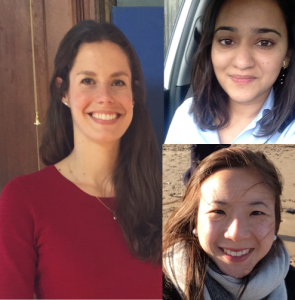
Ashika Sequeira trained on the Bromley GP Scheme and is a Locum General Practitioner. Alexandra Grove is an ST2 trainee in General Practice in the Tower Hamlets training scheme, East London. Vanessa Oo is a GPST2 in the UCLH GP training scheme.
Work can sometimes feel like a battle: a daily struggle to engage with our ever increasing list of patients and their complex co-morbidities. One of the challenges we face is a society which promotes unhealthy practices. Despite a growing awareness of the negative impact of poor diet and sedentary lifestyles on health, effective preventative care is increasingly difficult to deliver in our time-pressured consultations. Empowering our patients to proactively manage their health has never been more important in the role of a GP.
Our recent experience working with a homeless charity has opened our eyes to ways we as GPs can tackle preventative care through collaboration with community groups. Through Team Up, (an initiative bringing charities and trainee health professionals together to improve health), we worked with Single Homeless Project (SHP), a charity organisation based in North London.
Our aim was to provide the charity’s homeless clients with a simple, sustainable intervention to improve their health.
There were several challenges: the clients were difficult to engage in regular healthcare promotion and re-attendance was low. The homeless population in general has a higher incidence of medical and psychological morbidity, exacerbated by factors such as smoking, alcohol and drug abuse.1,2,3 Barriers to accessing healthcare in this population often leads to multiple presentations to A&E, a difficult and inappropriate environment for preventative care.
An extensive survey by the charity identified 70% of their clients were interested in taking part in some sort of exercise and 60% were interested in exploring their community.4
This led to the idea of a regular walking group for clients within SHP’s existing geographical sites. We decided to deliver health promotion through SHP’s existing staff to take advantage of their personal relationship with clients and to ensure the project would be sustainable. We designed an interactive session based on the theme of exercise to be delivered to SHP’s staff.
Feedback from both staff and managers was that the presentation was accessible and served to highlight the usefulness of health statistics in relating the impact of walking to a healthier lifestyle. 65% of staff felt they would not be able to discuss exercise confidently with their clients and over 87% did not know the current Department of Health recommended exercise guidelines. Following our intervention, this increased to 100% in both domains. ‘It’s easy to forget about exercise when dealing with clients who may be living in chaos, I hadn’t thought about what they might already be doing as a way of highlighting other strengths’ commented one staff member.
The momentum has continued to build. SHP walking groups have now been set up at least monthly in four London boroughs. Part of their success has been SHP enthusiastically taking over the original idea, developing their own versions, including mushroom collecting and photography walks to suit their smaller groups. One of SHPs most encouraging comments has been that it has put exercise on the agenda for their charity.
These successes have demonstrated the power we have as health professionals to involve health as part of the conversation with charities. Charities have a wealth of experience with patients we may otherwise find difficult to engage. They provide a unique understanding of the community, can provide local links to resources and have often built up years of trusting relationships with clients.
GPs working in partnership with such community groups could provide effective prevention and health education to a much larger population than within the confines of a consulting room. Furthermore, working with a charity can be an invigorating way to flex a different part of your brain and develop a unique skill set. It was really enriching to take on an organisational role and work with specialists from another discipline.
Of course, with primary care already at breaking point and resources thin on the ground, we are certainly not suggesting this should further overburden GPs at the expense of regular patient care. CCGs should encourage building networks between GPs and community groups and provide funding for GPs to support these groups. We would argue, in the long term, this represents a more efficient model for health promotion and providing preventative care, particularly in populations with significant barriers to access. In resource-pressured times, we need to think outside the box. It’s time to come together with charities – for our patients, for our NHS, and even for us.
References
1. Schanzer B, Dominguez B, Shrout PE, Caton CLM. Homelessness, health status, and health care use. Am J Public Health. 2007;97:464–469
2. Chau S, Chin M, Chang J, et al. Cancer risk behaviors and screening rates among homeless adults in Los Angeles County. Cancer Epidemiol Biomarkers Prev. 2002;11:431–438.
3. Fischer PJ, Breakey WR. The epidemiology of alcohol, drugs, and mental disorders among homeless persons. Am Psychol. 1991;46:1115–1128.
4. Single Homeless Project, London. Available at http://www.shp.org.uk.








